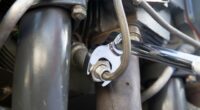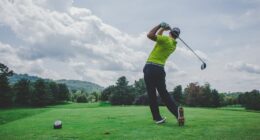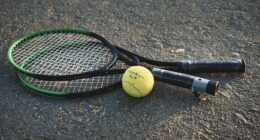Hurling and camogie are both Irish sports that involve a stick and a ball. The main difference between the two is that hurling is played by men, while camogie is played by women.
What is hurling?
(Image by Elsupero from Pixabay )

Hurling is an outdoor team sport of Irish origin that is played with a stick (called a hurley) and a small ball (called a sliotar). The objective of the game is to use the hurley to hit the sliotar between the opposing team’s goalposts either over the crossbar for one point or under the crossbar into a net for a goal, with the team scoring the most points and goals being declared the winner.
What is camogie?
(Photo by Óglaigh na hÉireann on flickr)

Camogie is a sport that originated in Ireland and is played by women. It is similar to hurling in that it involves the use of a stick (called a camán) and a ball (called a sliotar), but there are some key differences in the rules and gameplay. In camogie, there is no physical contact between players, and the ball can be caught in the hand and carried for a short distance before being struck with the camán. The objective of the game is to score points by hitting the sliotar over the opposing team’s crossbar, or to score goals by hitting the sliotar into the opposing team’s net.
Hurling Vs. Camogie – Key differences
Hurling and camogie are two sports that share many similarities, but there are some key differences between the two. Here are some of the main differences:
Gender: Hurling is played by men, while camogie is played by women.
Physical Contact: In hurling, physical contact between players is allowed, while in camogie, there is no physical contact between players.
Playing Field: The playing field for hurling is larger than the field for camogie. A hurling field is typically around 137m long and 82m wide, while a camogie field is around 130m long and 80m wide.
Stick: The stick used in camogie is generally smaller and lighter than the hurley used in hurling.
Ball: The sliotar used in camogie is slightly smaller and lighter than the sliotar used in hurling.
Scoring: In hurling, a goal is worth three points, while in camogie, a goal is worth only one point. Additionally, in camogie, a player can score a point by striking the sliotar over the crossbar, while in hurling, a point can be scored either over the crossbar or between two posts.
These are just a few of the key differences between hurling and camogie. Despite these differences, both sports share a rich cultural heritage and remain popular in Ireland and around the world.
The rules of hurling
The rules of hurling are quite simple. The game is played with a stick and a ball, with the objective being to score the most points by hitting the ball into your opponent’s net. There are two types of nets, one for goals and one for points. A goal is worth three points, and a point is worth one point.
The game is played on a pitch that is 150-200 meters long and 90-100 meters wide. The pitch is divided into two halves by a line called the halfway line. Each team has its own half of the pitch, and there is a goal at each end of the pitch.
The game starts with a coin toss, and the team that wins the toss gets to choose which end they want to attack. The game then starts with a player from each team taking turns throwing or ‘pucking’ the ball from their own half of the pitch towards their opponents’ goal. In order to score a point or goal, the ball must be hit into the net using only the flat side of the stick. The team with the most points at the end of the game wins!
The rules of camogie
The rules of camogie are very similar to the rules of hurling, with a few key differences. The most notable difference is that in camogie, only the flat side of the stick may be used to strike the ball. This means that players must use a different technique to strike the ball compared to hurling, which can make the game feel quite different. Camogie also has a smaller pitch and fewer players than hurling, which can make the game feel more intimate and fast-paced. Another key difference between the two sports is that in camogie, players are not allowed to pick up the ball with their hands – they must use their sticks. This can be a challenge for beginners, but once you get used to it, it’s great fun!
What’s the difference between hurley and camogie stick?
The main differences between a hurley and a camogie stick are:
Size and Weight: A hurley is generally larger and heavier than a camogie stick. A hurley can be up to 37 inches (94 cm) long and weigh up to 16 ounces (454 g), while a camogie stick is usually shorter and lighter, weighing between 10 and 12 ounces (283-340 g).
Shape: The shape of a hurley is more curved than a camogie stick, which has a flatter shape. The curved shape of a hurley allows players to strike the sliotar with greater force and accuracy.
Grip: The grip of a hurley is often thicker and more textured than a camogie stick, which allows for a stronger grip and better control of the stick.
Material: Traditionally, hurleys are made from ash wood, while camogie sticks can be made from a variety of materials, including ash, hickory, and composite materials.
Design: The design of a hurley and a camogie stick can vary depending on the manufacturer, but generally, hurleys have a more traditional and rustic look, while camogie sticks may have a more modern or stylized design.
These differences reflect the different styles of play in hurling and camogie, as well as the physical differences between male and female players.
Why do camogie players wear skirts?
Camogie players traditionally wear skirts as part of their uniform. The skirts are usually made from the same material as the jersey and are often worn over shorts. The tradition of wearing skirts in camogie dates back to the early 20th century when the sport was first established. At the time, women’s sports were often viewed as unfeminine, and the skirt was seen as a way to make the sport more acceptable to society. Today, many camogie players continue to wear skirts as part of their uniform, although some teams have switched to shorts or skorts (a combination of shorts and a skirt) as a more practical and comfortable alternative. However, the decision to wear a skirt or shorts is ultimately up to the individual player and the team’s preferences.
Is fighting allowed in hurling?
No, fighting is not allowed in either hurling or camogie. If a player commits an offence that is deemed to be violent, such as striking another player with a hurley, they will be shown a red card and will be dismissed from the game.
Can you tackle in camogie?
No, tackling is not allowed in camogie. Camogie is a non-contact sport, which means that physical contact between players is not allowed. Instead, players use their sticks to block and intercept passes, and to try to dispossess their opponents of the sliotar. While there can be some incidental contact during play, deliberate physical contact, such as pushing or tripping, is not allowed and can result in a free or penalty being awarded to the opposing team. The rules of camogie prioritize skill, speed, and agility, rather than physical strength or aggression, making it a game that requires a high level of skill and finesse.
Featured Image By – Adrian Payne on Unsplash








